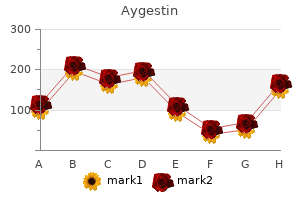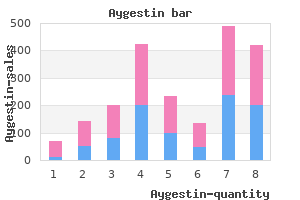"Discount aygestin, women's health clinic calgary ne".
By: U. Leif, M.A., M.D., M.P.H.
Clinical Director, Osteopathic Medical College of Wisconsin
Cheap aygestin online amex
They include neutrophils (granules stain with neutral dyes), eosinophils (granules stain with eosin) and basophils (granules stain with basic dyes). Prognosis An assessment of the likely outcome of the disease judged from general experience of the disease and the age and condition of the individual patient. Prophylaxis, Active Administration of an antigenic agent to actively stimulate an immune mechanism. Prophylaxis, Passive Use of antiserum from another individual or animal to provide temporary (7-10 days) protection against a specific infectious or toxic agent. Proteasome inhibitors also induce apoptotic cell death, and thus are being studied for the treatment of cancer. Recombinant Vaccine Use of a recombinant antigen preparation in combination with an adjuvant, which may be administered prophylactically or therapeutically to induce viral neutralizing proteins and other protective immune responses. Replicon A tandem region of replication (about 30 microns in length) in a chromosome derived from an origin of replication. Rhinitis An inflammation of the nasal passage which is characterized by frequent and/or repetitive sneezing, runny or congested nose and itchiness of the nose, eyes and throat and may also be associated with headache, impaired smell, postnasal drip, conjunctival symptoms and sinusitis. The most common form of rhinitis is allergic rhinitis which is classified as perennial, seasonal or occupational, depending on the time of allergen exposure. Less common subtypes include hormonal rhinitis (occurring during pregnancy or in patients with hypothyroidism), nonallergic or vasomotor rhinitis, infectious rhinitis and drug-induced rhinitis. See also Coryza Rhinovirus A member of the Picornaviridae family of viruses that commonly infects the upper respiratory tract. Ribonucleotide A nucleotide in which a purine or pyrimidine base is linked to a ribose molecule. Many antibiotic agents bind to the 30S and 16S subunits of the bacterial ribosome. The utility of ribozymes as biologic and therapeutic agents has been limited due to their susceptibility to chemical and enzymatic degradation and to restricted target site specificity. The most commonly affected sites are the lungs, lymphatic system, skin and eyes; the upper respiratory system, liver, bone marrow, spleen among other organs can also be affected. See also Sepsis and Sepsis, Severe Seroconversion the development of detectable specific antibodies to a virus or other microorganism in the serum as a result of infection or immunization. It is characterized by fever and coughing or difficulty breathing or hypoxia and can be fatal. Depending on their cytokine profile, they are divided into Th0, Th1, Th2 and Th3 subsets. These cells are effective against intracellular pathogens such as viruses, bacteria and parasites. These cytokines enhance humoral responses by helping B cells in the production of different classes of immunoglobulins (Igs). Thrombocytopenia A condition characterized by a decrease in the number of platelets in the blood. It is cleaved into seraspenide which inhibits the entry of hematopoietic pluripotent stem cells into the S-phase.
Syndromes
- Jerky movements (short, seizure-like movements)
- Medications such as phenazopyridine (used to treat urinary tract infections), rifampin, and warfarin
- Swelling of the left lower heart chamber
- Checking your blood flow (circulation)
- Finasteride (Propecia, Proscar), a pill that interferes with the production of a highly active form of testosterone that is linked to baldness. It slows hair loss. It works slightly better than minoxidil. Hair loss returns when you stop using this medicine.
- Hearing loss

Discount aygestin
Revision Date September 8, 2017 208 Head Injury Aliases None noted Patient Care Goals 1. Administer oxygen as appropriate with a target of achieving 94-98% saturation 209 b. If patient unable to maintain airway, consider oral airway (nasal airway should not be used with significant facial injury or possible basilar skull fracture) c. Assume concomitant cervical spine injury in patients with moderate/severe head injury 3. Geriatric Consideration: Elderly patients with ankylosing spondylitis or severe kyphosis should be padded and immobilized in a position of comfort and may not tolerate a cervical collar Notes/Educational Pearls Key Considerations 1. If endotracheal intubation or invasive airways are used, continuous waveform capnography is required to document proper tube placement and assure proper ventilation rate 4. Prognostic factors in civilian gunshot wounds to the head: a series of 110 surgical patients and brief literature review. Influence of prehospital treatment on the outcome of patients with severe blunt traumatic brain injury: a single-centre study. The relationship between out-of-hospital airway management and outcome among trauma patients with Glasgow Coma Scale scores of 8 or less. Inappropriate prehospital ventilation in severe traumatic brain injury increases in-hospital mortality. Effect of secondary prehospital risk factors on outcome in severe traumatic brain injury in the context of fast access to trauma care. Prehospital intravenous fluid administration is associated with higher mortality in trauma patients: a National Trauma Data Bank analysis. Clinical policy: neuroimaging and decision making in adult mild traumatic brain injury in the acute setting. Part 14: pediatric advanced life support: 2010 American Heart Association guidelines for cardiopulmonary resuscitation and emergency cardiovascular care. Adult Trauma Clinical Practice Guidelines: Initial Management of Closed Head Injury in Adults: 2nd Edition. Prioritization for extraction is based on resources available and the situation. Encourage patients to provide self-first aid or instruct aid from uninjured bystander g.

Generic 5 mg aygestin with visa
In Further studies are required before recommendations can be made addition the restrictive lung function may be due to softening of the regarding this treatment modality. Ipratropium and the longer acting salmeterol will improve this complication does not occur during the acute phase of spinal lung function in up to 50% of tetraplegics. The condition can be triggered by various stimuli, noxious and non-noxious including cardiovascular management surgery, bladder distension, bowel distension and cutaneous stimuli. Cardiovascular instability is particularly seen with high cervical It is more common in complete and higher lesions; it is rarely cord injuries. At the time of injury there is an initial brief period of seen in patients with cord lesions below T10. The condition is increased sympathetic activity resulting in hypertension, an increased due to massive sympathetic discharge. This is followed weeks to years following the spinal injury and include paroxysmal by a more sustained period of neurogenic shock, resulting from loss hypertension, headaches and bradycardia. Below the lesion cutaneous of sympathetic outfow from the spinal cord, which may last up to vasoconstriction, piloerection and bladder spasm may be seen. This is characterised by vasodilatation and bradycardia the lesion there may be fushing, sweating, nasal congestion and and tends to be seen only in lesions above T6. The patient may complain of blurred vision loss of cardiac sympathetic aferents and unopposed vagal activity and and nausea. In persistent If left untreated complications include stroke, encephalopathy, and problematic bradycardia a pacemaker may need to be inserted. Management loss of sympathetic innervation to the heart means that if increases in options include removal and avoidance of triggers. If surgery is planned, consider the use of spinal anaesthesia as this reliably prevents the symptom complex. Other options include the initial treatment of hypotension involves intravenous fluid increased depth of anaesthesia and vasodilators for the treatment of administration. Once the stroke volume cannot be increased further, hypertension and making use of orthostatic hypotension by placing then vasopressors will need to be commenced using either dopamine 8 patients with legs down. Prophylaxis must trauma, autoregulation of blood fow to the cord fails and hence fow be started as soon as possible although there is no consensus as to becomes directly proportional to systemic blood pressure; therefore to exactly when or how this should be initiated. Treatment can be divided ensure sufcient perfusion to the cord systemic blood pressure must into two clear groups, pharmacological and non-pharmacological. Gastrointestinal management Indications for surgery include correction of deformity, stabilisation of Bleeding due to stress ulceration should be prevented with an H2 the spine and decompression of the spinal cord to allow neurological receptor antagonist, such as ranitidine. Early surgical decompression has been shown to be benefcial can be treated with nasogastric suctioning and prokinetic drugs.

Order aygestin 5mg free shipping
Classification based on individual ingredients of the mixture Category 1 Does the mixture contain one or more ingredients classified as a 1 Yes Category 1 mutagen at 0. Danger No Category 2 Does the mixture contain one or more ingredients classified as a 1 Yes Category 2 mutagen at 1. See modified demonstration of mutagenic properties of chemicals in somatic and/or germ cells of mammals in vivo may have classification on a case-by-case basis below. Warning No Not classified Classification based on a case-by-case basis Classify in appropriate category Are the test results on the mixture conclusive taking into account dose and Are test data available other factors such as duration, for the mixture itself Substances and mixtures which have induced benign and malignant tumours in well performed experimental studies on animals are considered also to be presumed or suspected human carcinogens unless there is strong evidence that the mechanism of tumour formation is not relevant for humans. Classification of a substance or mixture as posing a carcinogenic hazard is based on its inherent properties and does not provide information on the level of the human cancer risk which the use of the substance or mixture may represent. An individual substance may be further distinguished: Category 1A: Known to have carcinogenic potential for humans; the placing of a substance is largely based on human evidence. Category 1B: Presumed to have carcinogenic potential for humans; the placing of a substance is largely based on animal evidence. Based on strength of evidence together with additional considerations, such evidence may be derived from human studies that establish a causal relationship between human exposure to a substance and the development of cancer (known human carcinogen). Alternatively, evidence may be derived from animal experiments for which there is sufficient evidence to demonstrate animal carcinogenicity (presumed human carcinogen). In addition, on a case by case basis, scientific judgement may warrant a decision of presumed human carcinogenicity derived from studies showing limited evidence of carcinogenicity in humans together with limited evidence of carcinogenicity in experimental animals. Based on strength of evidence together with additional considerations, such evidence may be from either limited evidence of carcinogenicity in human studies or from limited evidence of carcinogenicity in animal studies. The evaluations should be based on all existing data, peer-reviewed published studies and additional data accepted by regulatory agencies. The full list of factors that influence this determination is very lengthy, but some of the important ones are considered here. There is great variability in potency among chemicals, and it may be important to account for these potency differences. The relative emphasis accorded to each factor depends upon the amount and coherence of evidence risk assessment. The classification may be modified on a case (d) Reduced tumour latency; by-case basis based on the available test data for the mixture as a whole. In such cases, the test results for the mixture as a whole must be shown to be conclusive taking into account dose and other factors such as duration, observations and Additional factors which may increase or decrease the level of concern include: analysis. A substance that has not been tested for carcinogenicity may in certain instances be classified in Category 1 or Category 2 based on tumour data from a structural analogue together with substantial support from consideration of other important factors such as formation of common significant metabolites. Sufficient human evidence demonstrates causality between given route(s); or whether there are only local tumours at the site of administration for the tested route(s), and adequate human exposure and the development of cancer, whereas sufficient evidence in animals shows a causal relationship testing by other major route(s) show lack of carcinogenicity. Limited evidence in humans is demonstrated by a positive association between exposure and cancer, but a causal relationship cannot be stated.
Cheap aygestin online amex. Womens Health - Menopause.

